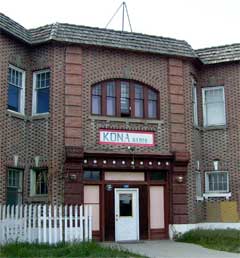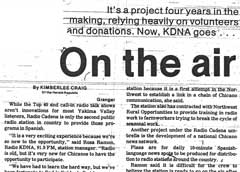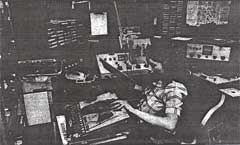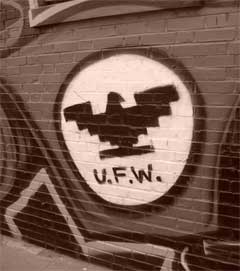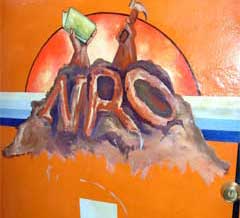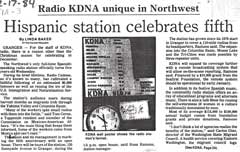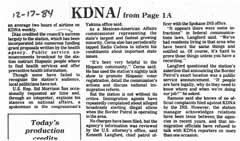By the late 1970s, the national Chicana/o Movement was losing its footing. The rise of political conservatism during the1980s under the “Reagan Revolution” not only made protesting difficult, it also rolled back of many gains of the 60s and early 70s. Yet the advent of the political right in the late 1970s also prompted responses from still active elements of el Movimiento. The farm worker movement in Washington State revived in the late 1970s and 1980s, with the creation of Radio Cadena or Radio KDNA. Several Chicano/a leaders formerly engaged in el Movimiento in Washington State established Radio KDNA, an activist radio station that educated farm workers, advocated farm worker’s organizations, and provided Spanish language programs to non-English speaking families. Soon after the establishment of Radio KDNA, the United Farm Workers of Washington State organized in the lower Yakima Valley.
By the late 1970s, Chicano/as engaged in el Movimento largely focused on labor issues, immigration rights, and solidarity with Central and South American communities struggling against right wing military governments, most of whom were supported by the Reagan Administration’s staunch “anti-Communist” stance. The Mexican economic crash as well as the mass migration of Central American immigrants to the U.S. in the 1980s fused the farm worker cause or la causa with the cause of immigrant rights. Recent immigrants supplanted U.S-born ethnic Mexicans as the primary workforce in Washington’s agricultural industry. This fusion of farm worker and immigrant rights reshaped the farm worker movement in Washington State and made it what it is today.
In the social atmosphere of the late 1970s and early 1980s, the creation of Radio KDNA revived farm worker’s struggles and served to educate workers of their rights. Radio KDNA was only the second non-commercial Spanish language radio station established in the U.S., after KBBF in Santa Rosa, California. It proved an invaluable resource for farm workers in the Pacific Northwest.
Radio KDNA was among the most ambitious projects to emerge from the latter part of el Movimiento in the Yakima Valley. According to Ramon Chavez, in 1979, the local media at the time regarded all migratory laborers as second-class citizens.1 As he states, “because of this situation, the Anglo newspapers of the valley came to be regarded by Chicanos as part of the power structure with Chicanos accusing them of reflecting the attitudes and prejudice of Anglo residents.”2 It was no surprise then that Chicano/as sought to build media institutions that would be responsive to the Latino/a community’s concerns. According to Ricardo Garcia, Radio KDNA Executive Director, “many farm workers d[id] not read…we decided that radio was a natural means of communication [because] farm workers needed [and had no other source providing] information about housing, health, pesticide exposure, education for children and parents.”3
Radio KDNA was not established overnight, but rather took several years to create. Beginning in September 1975, a grassroots committee titled the “Northwest Chicano Consilio” contacted FM radio stations in Washington, Oregon, and Idaho with the intent of creating a Tri-state Subsidiary Communications Authority. They constructed a small radio studio in Lynden, Washington and designed informational campaigns by taping Spanish-language public service announcements, public affairs programs, and educational services for migrants and seasonal agricultural workers.4
The efforts of the Northwest Chicano Consilio resulted in the Northwest Chicano Radio Network (NCRN), a station that was officially incorporated in 1976 under contract with KRAB FM of Seattle. According to KDNA Station Manager, Gabriel Martinez, “During this time NCRN submitted an application to the Federal Communications Commission (FCC) for a construction permit to build a non-commercial educational FM radio station. After realizing the cost for calling from Seattle to Granger [lower Yakima Valley] to send news feeds was expensive and because the Yakima Valley was the home of many farm workers NCRN decided the station should be in Eastern Washington.”5
After its establishment, members of the NCRN requested facility space from Northwest Rural Opportunities (NRO) in Granger, Washington. In 1977, The NRO agreed to lend NCRN the space, as long as they created a career-training program to train farm workers in radio broadcasting. NCRN built studios on the grounds of the NRO headquarters, with the FCC finally granting the station a license on October 29, 1979 and the call letters “KDNA” for “Cadena.”6 At noon on December 19, 1979, with the aid of staff and volunteers, KDNA 91.9 FM went on the air, effectively bringing the struggle for farm worker justice and social equity to the airwaves. Radio KDNA would soon become “la voz del campesino/the voice of the farm worker,” providing Latino/as and other minorities an avenue of communication.7
In anticipation of the unprecedented activity not only in the Yakima Valley, but also in the Pacific Northwest, the Yakima Herald Republic ran a front-page article on the radio station. In this article, Rosa Ramón, the station’s manager (one of the few Chicanas in the country to hold such a post) expressed the station’s larger focus when she noted that there would also be programs in English: “We don’t want to be limited to Spanish speaking listeners….we also want to serve the black, Filipino, Yakama Indian and Anglo populations.” In addition, the Yakima Herald-Republic also mentioned that “[a]n advisory board, made up of representatives from various cultural backgrounds, has been formed to ensure the radio station keeps in touch with the valley’s different ethnic communities.”8
The station’s main purpose was to educate, with programs focusing on consumer information, nutrition and food, women’s issues, immigration issues, unemployment and labor conditions, youth and senior citizen issues, 1980 census information, news coverage of topics of interest to Chicana/os such as “Cinco de Mayo” celebrations, and a locally produced, English-language show on jazz and blues music. Yet another project under the Radio Cadena umbrella was the development of a national Chicano news network. “Under the project, the station [would] be provided news items from some 50 Spanish language and Chicano radio stations throughout the country. KDNA [then] condense[d] the news content into 10-minute news summaries.” In effect, the station would “function as a national news coordinating center and [serve] the Spanish speaking community in much the same way the national wire services provide news for the general audience.”9 By the early 1980s, the station would cultivate a faithful following of an estimated 80,000 listeners, with many more listening during harvest season. Because of a rise in immigration from Central and Latin America, the station would also draw unwanted listeners, such as the Immigration and Naturalization Service (INS).
In the wake of the collapse of the Mexican economy in 1982 as well as the prolongation of the “dirty wars” in Central and South America, migration of Latin Americans to the U.S. had increased. The aid that the Reagan Administration provided to right-wing military governments in the Americas under the auspices of a renewed, staunch anti-communist fervor created the desperate conditions that led many people, especially those involved in labor movements, to escape northward, fearing government death squads. This had great implications regionally as these recent Latin American immigrants became the most significant demographic group within the farm labor workforce in Washington State. As a result, the movement for farm worker justice soon incorporated an immigrant rights component. During this time, the INS (now known as Immigration and Customs Enforcement, or ICE) “began cracking down on undocumented farm workers in south central Washington State, staging raids in local communities during the busy harvest season. After each raid, a new group of workers would be recruited from other towns to fill jobs left vacant by the detentions. More raids would follow.”10
In response to INS raids in the Yakima Valley, the staff of Radio KDNA, out of its concern for the well-being of farm workers and their families, devised a subtle yet effective way of alerting workers of INS roundups. To warn workers of a potential INS raid, they would air a song about la migra, dedicating it to the town that was being raided. “People understood our unspoken message,” said the station’s general manager, Gabriel Martinez.11 This was especially useful and effective because the Yakima Valley had “become home to the fourth-largest migrant farm worker population in the US. Some 60,000 Spanish speakers make up 30 percent of the population during harvest season—the majority employed as farm workers.”12
Relations were tense between KDNA and the INS, with immigration officials refusing to speak with KDNA reporters on many occasions. As the Yakima Herald-Republic asserted, many INS agents complained repeatedly about alleged broadcasts alerting unauthorized residents to Border Patrol agents’ operations. Kenneth Langford, then chief patrol officer with the Spokane INS office, mentioned “[i]t appears there were some infractions [in federal communications laws]… “If people are here legally, why do they need to know where and when we’re doing our job?”13
KDNA thus became a hub for most of Central Washington’s immigrant farm worker community. “Cesar Chavez appeared several times as a guest in the ‘80s, speaking about the movement to organize farm workers. State and local government officials have addressed current issues on KDNA as well. And the farm workers themselves frequently host shows.”14 Community activist Ninfa R. Gutierrez is still involved in programming that offers resources to immigrant women whom encounter language barriers and whom may not otherwise have access to basic services, such as health care. Gutierrez summarizes KDNA’s community influence best when she states: “People arrive here, particularly from Mexico…they land in this valley, can’t find employment, can’t speak the language, have no family. KDNA lets them know that they’re not alone.”15
By standing in solidarity with marginalized workers and immigrants in the Yakima Valley, Radio KDNA earned a sterling reputation that would result in region-wide acclaim and recognition at the national level. The National Federation for Community Broadcasters’ (NFCB) Community Impact Award was awarded to KDNA three years in a row. Since going on the air, the station has been one of the most productive and visible community institutions in the Yakima Valley and in Washington State as a whole, outliving even Northwest Rural Opportunities, with whom it shared a building in Granger.
Next: Ch. 9, The Resurgence of the UFW of WA State in the 1980s
“A History of Farm Labor Organizing, 1890-2009” includes the following chapters:
- Toward a History of Farm Workers in Washington State
- The IWW in the Fields,1905-1925
- The 1933 Battle at Congdon Orchards
- Asians and Latinos Enter the Fields
- Mexican-American Struggles to Organize, Post-WWII
- El Movimiento and Farm Labor Organizing in the 1960s
- UFW’s Yakima Hop Strikes, 1971
- Radio KDNA: The Voice of the Farm Worker
- Resurgence of the UFW of WA State in the 1980s
- The Struggle Continues, 1997-2006
- Bibliography
Copyright (©) Oscar Rosales Castañeda 2009
1 For an analysis of the role media played in the Chicana/o community of Washington, see Ramon Chavez, “Emerging Media: A History and Analysis of Chicano Communication Efforts in Washington State,” Master’s Thesis, University of Washington, 1979.
2 Ibid., 85.
3 Jonathan Lawson, “Voices from the Valley,” Yes! 20 May 2004. Available online at: <//www.yesmagazine.org/article.asp?ID=560>
4Gabriel Martinez , “A Brief History of Radio Cadena,” 2008. Available at the Radio KDNA website: <//www.kdna.org/en-US/history>
5 Ibid.
6 Cadena means “chain” in English. This title symbolized the project’s original goal of creating a chain of stations to serve the educational, social, and political needs of the community, and to advocate for farm worker justice and labor rights in general.
7 According to the KDNA website, the station’s mission is to “direct its efforts as a minority public radio station in response to the cultural and informational isolation of Hispanic/Latino and other disadvantaged communities. Radio KDNA will produce quality radio programming to help such communities overcome barriers of literacy, language, discrimination, poverty and illness. In this way, KDNA will empower these communities to more fully participate in our multi-ethnic society.” See “Mission,” Radio KDNA website, 2008. Available online at: <//www.kdna.org/en-US/our-mission>
8 Kimberlee Craig, “On The Air,” Yakima Herald-Republic, 17 December 1979, 3-1.
9 Ray Chavez, “Chicano Station,” Yakima Herald-Republic, 19 March 1980, 3-1.
10 Lawson, “Voices from the Valley.”
11 Ibid.
12 Ibid.
13 Linda Baker, “On The Air,” Yakima Herald-Republic, 17 December 1984, 1A-3.
14 Lawson, “Voices from the Valley.”
15 Ibid.

